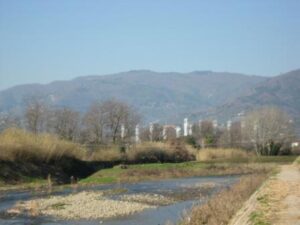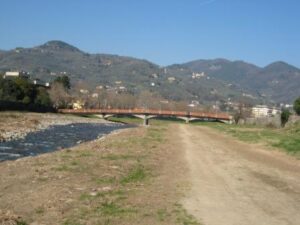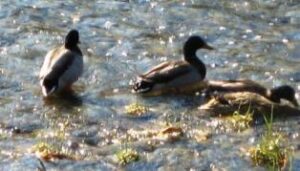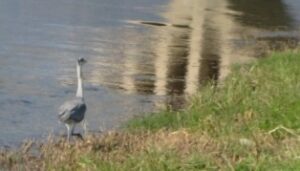Trekking along the river
The trail

- along the river

- along the river
Departure from Pescia is suggested (from Passerella Sforzini) where there are parking lots nearby. Trekkers will walk down the left side of the river, where mallards and other species of wild ducks can be observed. Here the trail is covered with glass. Trekkers pass under the Ponte Europa, then under the Ponte del Marchi; and then proceed on an unpaved stony trail. After half an hour from the point of departure they will reach the Ponte della Ferrovia and cross the Passerella Furicaia upon the homonymous stream that flows into Pescia di Pescia river. Trekkers will proceed along the rail, following the meandering river; on their right, the Montecarlo hill can be observed, famous for its excellent white wine production and the soaring village bell tower. On the left, hills covered with olive groves stretch west encompassing the Medieval hamlets of Valdinievole: Uzzano, La Costa, Buggiano, Colle, Cozzile, Stignano, Massa and Montecatini Alto. Far off in the west horizon, the hill dominated by Monsummano Alto can be seen, thanks to remains of the large quarry and, below on the right, Montevettolini can be admire. On the flatlands beneath, Montecatini Terme and Monsummano Terme, famous for their thermal waters, are nestled.
A wide valley unfolds in front of trekkers’ eyes: the panorama is characterized by the glittering glass of greenhouses, testimony to the local flowers and plant nursery system that boast a strongly rooted tradition in this area. And, then, far in the horizon stretches the grand basin of Padule del Fucecchio (Fucecchio Marshes), bound to the east by the Cerbaie hills. The itinerary proceeds across paved roads and is still marked by specific signs and made easier by pedestrian crosswalks. After approximately a one and a half hours walk from the point of departure, trekkers will cross the Ponte Severini, then the Ponte Uzzanese and the Ponte Camporcioni, where attention must be paid due to motor traffic on the Via Camporcioni. Along this portion of the itinerary, trekkers will most likely see the skilful swimming of coypus in the river. Trekkers will then proceed along the grassy bank of the Pescia di Pescia river up to the village of Ponte Buggianese, which should be reached after approximately two and a half hours of walking. Here, trekkers leave behind the river bank and walk down Via Garibaldi up to Piazza del Santuario (Sanctuary Square). Here a refreshment is a must! Shops are also open on Sundays and fresh fruit juices, fresh fruit, hand-made ice creams, and anything else you might have forgotten to take with you, can be purchased. If you are not in a hurry, a visit at the Sanctuary, located right in the square, was frescoed by Pietro Annigoni. Looking at the Sanctuary, trekkers will take the narrow road on their right, Via Giusti, crossing Via Puccini – signs signaling the trail are visible- pay attention to traffic even thought pedestrian crosswalks are present. The Ponte della Vittoria will then be crossed and the trail continues on the right bank of the river. An endless view will extend in front of trekkers’ eyes: on the left, up to the faraway hills with Montecatini Alto; and opposite, below, Serravalle and the hill of Monsummano Alto, characterized by the remains of the ancient gravel quarries. The trail continues heading for the Ponte alla Guardia: on the left hand side of the river, a ribbon of flower and plant nurseries can be seen; on the right hand side, cultivated lands and scattered country houses; in the background, the Cerbaie hills and the Pisa mountains, where Mount Serra soars, recognizable for its high antennas that pierce the sky. Trekkers will reach the Ponte di Mingo, where the poplar woods that interrupt the linearity of the basin can be admired. Via Gentile will be crossed and the trail will be proceeds along the river bank up to the Ponte Galligani, which trekkers will reach after approximately one hour walk from the village of Ponte Buggianese. Follow the signs and turn left onto a paved road, Via Giatta: trekkers will leave behind the river bank and will walk along a ring that leads to the Monaca-Righetti Natural Reserve. After 200 meters (220 yards), trekkers will leave Via Giatta, as it curves to the left, and walk straight ahead. The road you will take is Via Prato Grande and on the right you will see a memorial erected in memory of the people who lost their lives in the slaughter by the German army in ’44. The road begins as paved and then becomes unpaved as it turns left, passes in front of a splendid brick building of the former Prato Grander Tobacco Factory, testimony to a flourishing past of business activity. The Padule (Marshes) is teeming with former cigar and tobacco factories. Continuing along the gravel road, after four hours of walking from Pescia and one and a half hours from the village of Ponte Buggianese, the Grand Lake and a vast poplar wood will be visible on the left, while on the right, beyond the Fosso del Vescovo, stretches in all of its beauty and marvel the Monaca-Righetti Natural Reserve, where a plethora of most interesting bird species can be admired. Trekkers will proceed along the gravel road and, on the left, will pass by some further memorial plaques in rememberence of the victims of the Marsh slaughter and wide expanses of cultivated land; on the right hand side, the road is flanked by the Fosso del Vescovo. Trekkers will pass by Via Giardino up to the Ponte alle Ragnaie, which they will leave on their right hand side as they turn left onto Via Ragnaia. From there, they will take Via della Prata on their left, and then Via Fattoria on their right. Then they will take Via Ponte alla Guardia concluding the ring-shaped trail and return to the Pescia di Pescia river bank at the height of the height of the Ponte alla Guardia. At this point they will head back by walking along the left bank of the river to the villages of Ponte Buggianese, Chiesina Uzzanese and Pescia. If you have extra time, you can reach several places to purchase locally produced cheese from Ponte alle Ragnaie.


In the neighborhood
We find ourselves in the heart of Valdinievole: is it the Nievole valley or the valley of fog? Even though the first hypothesis is the most probable, that its name derives from the homonymous stream, on misty days the valley seen from above appears as a sea of fog, caused by the humidity of the Fucecchio Marshes. But a little sunshine will burn it off and suddenly the ravishing countryside and charming little villages will pop out to visitors’ eyes. A beauty rich in variety, thanks to its diverse landscapes: from hills covered with olive groves to woods, cultivated flatland and, further south, the Marshes ( Padule). Diverse the nature of the land, likewise the history that marks the past of the several villages nestled on the rocky hills of this area. During the dark centuries of the Middle Ages, these isolated and difficult to reach villages were self- governing, defended by high walls, towers and fortress that are a rich historical testimony even today. The trail along the Pescia Valley crosses Pescia and Ponte Buggianese and continues near Buggiano, Chiesina Uzzanese and Uzzano – just a few names of places in the Valdinievole that are worth a visit.
Pescia
The “Town of Flowers” per excellence, thanks to its century – long of floral production, boasts the Marketing Center of Flowers for Central Italy, as well as the marvelous Biannual Florence Exhibition, Flower and Decorative Plants Fair – a rendezvous that has taken place in September for over fifty years. Pescia, the main town in Valdinievole, opens is gates to visitors through the Porta Fiorentina (Florentine Door). This imposing structure, decorated with baroque friezes and the Medici coat of arms, was build to pay homage to Gian Gastone de’ Medici.
After passing by the Porta Fiorentina, we find the Cathedral and the ancient Pieve of S. Maria, the little Romanesque church of S. Antonio, and finally the Church of Saint Francis, whose first stone is said to have been laid by the Saint himself while he was a guest of the Orlandi family.
On the opposite side of the town, on the right bank of the river, soars the group of official places: The Palagio (Palace), which hosts the Libero Andreotti Gypsum Artworks Gallery; the Museo Civico (Municipal Museum); the Palazzo del Podestà (Governor Palace); the Madonna di Piè di Piazza; the modern Flower Market; the Sismondi Villa, which today hosts the Municipal Library; and Via della Fiaba which, through the Marzalla, leads to Collodi, the Paese dei Balocchi (Toy Village) that attracts many visitors thanks to the Pinocchio Park, the monument erected for the puppet by Emilio Greco, the square of mosaics by Venturino Venturi, the “Osteria del Gambero Rosso” run by Giovanni Michelucci, the sumptuous Villa Garzoni and annexed gardens, and Collodi’s hometown, whose structure has remained untouched over the course of time with its little house that seem nestled one above the other on a slanted slope. From Pescia it is possible to reach the picturesque.